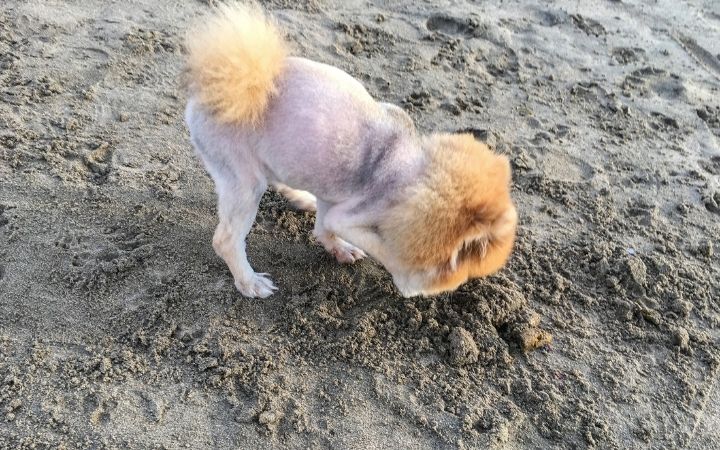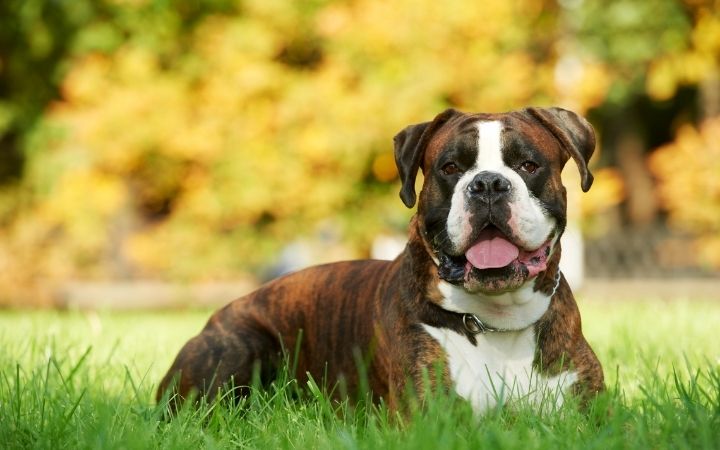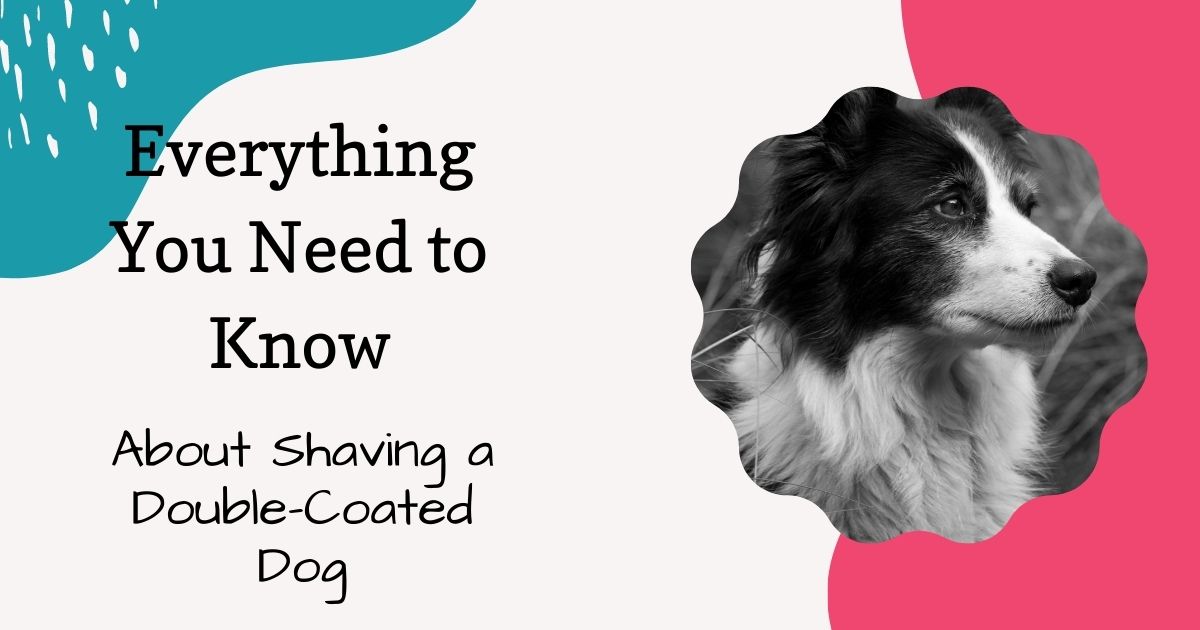Is it Recommended to Shave a Double-Coated Dog?
Is shaving your double-coated dog a good idea? Shaving a dog can actually have the opposite effect. Therefore, it is not recommended to shave a double-coated dog unless instructed by the vet for a medical condition.
Shaving a double-coated dog will remove their only protection from the cold, heat, and sun. This can lead to numerous skin issues such as dry skin, eczema, and sunburn. It can also result in the coat not growing back properly, leaving it a patchy mess.

Vets can recommend shaving certain areas of the body or the whole body. This is done if injuries, infections, or skin conditions require shaving to receive proper treatment.
Some Insights Into Double-Coated Dogs
A dog’s coat serves a purpose based on what the dog was bred to do. For example, dogs with double coats have a longer outer layer and a softer undercoat. These dual layers protect from the outside elements.
The inner layer of a double coat also acts as insulation. This keeps your dog warm in winter and cool in summer. In summer, a dog will shed a significant amount of the inner layer. What remains of the inner layer helps to capture air between the two coats. This allows dogs to stay cool and regulate their body temperature.
The outer layer, or “guard hairs,” allows cool air to circulate near the dog’s skin as they are longer. It is also the layer that gives a dog its color and is not shed as much as the temperature rises.
Many double-coated dogs have pale pink skin and are susceptible to sunburn. The guard hairs help to reflect the sun’s rays and protect the skin. The guard hairs also help to protect the dog from insect bites.
Examples of double-coated dogs include Golden Retrievers, Border Collies, German Shepherds, Labrador Retrievers, Huskies, and English Springer Spaniels.
Shaving a double-coated dog removes the benefits that the inner and outer layers provide. It prevents cool air from getting to the skin as the undercoat can still be present. This can lead to overheating. A shaved coat also doesn’t protect against the sun, which exposes your dog to the elements and risk of skin cancer.
Shaving a double-coated dog can result in improper hair growth. This can lead to the possibility of follicle damage. In addition, when shaved down to the skin, the undercoat typically grows back faster. This can cause crowding of the slower-growing guard hairs. This can change the texture and color of a dog’s coat. This can make it appear patchy and unattractive.
The Difference Between Single- and Double-Coated Dogs
On the other hand, single-coated dogs can be repeatedly shaved down. The shaving process doesn’t change the texture of the hair, and the hair can grow back normally.
Shaving a double-coated dog will change the texture of their coat. Guard hairs, once shaved, can become coarse. This can lead to things like burrs or twigs sticking to them. Inappropriate shaving can also cause skin irritations or hot spots.
Single-coated dogs include Greyhounds, Boxers, Dalmatians, Poodles, Maltese, and Afghan Hounds. They can have very short or long hair, but they don’t have an inner and outer layer, unlike double-coated dogs. They can have wiry, curly, or smooth hair, but alas, they are all even looking hairs with no soft undercoat.

The Alternatives to Shaving a Double-Coated Dog
While shaving a double-coated dog to help cool them down seems like a good idea, it clearly is not. These are some alternatives to help cool a double-coated dog down without having to shave them.
Dogs cool down differently than we do, and shaving doesn’t significantly impact helping them cool down. Instead, dogs rely on panting to control their temperature.
They also rely on blood vessels expanding in areas with a high surface area to help them cool off. This especially includes their ears and face. When the blood vessels expand, they bring hot blood closer to the skin surface and allow the outside temperature to cool them down.
Dogs also have merocrine sweat glands in their paw pads. These function like human sweat glands and activate when the dog is hot to cool it down.
Here are some alternatives to cooling down your dog when the temperature starts rising.
- Brush your dog regularly to remove dead hair and prevent matting. This is important to help remove the undercoat and allow for better air circulation.
- Regular cool baths to help shed the undercoat, keep them clean and free from external parasites.
- Keep the paws trimmed of excess fur. This allows more of the paw pads with sweat glands to contact the cool floor and allows the sweat to evaporate.
- Trim the fur on the legs and stomach to enhance cooling.
- Make sure your dog always has access to cool water and shade. Only take walks and exercise during the coolest times of the day.
- Never leave a dog unattended in a vehicle, even for a few minutes.
Two Methods of Shaving a Double-Coated Dog Explained
There are two methods of clipping a double-coated dog. These are known as the “Leave Some Behind” method or the “Naked Dog” method. Neither are recommended unless specified by a veterinarian.
Ensure that your dog is comfortable around clippers and not anxious. Have lots of treats on hand and be ready to take breaks as necessary.
Equipment Required:
- Heavy-duty clippers
- 2 x #3 blades for the “Leave Some Behind” method
- 2 x #10 blades for the “Naked Dog” method
- Clipper coolant
- Trimming scissors
- Comb with wide and narrow teeth
- Soft brush
- Restraint for the dog
Leave Some Behind Method
This method involves using the longest blade on the clippers. This ensures that some of the undercoat and guard hairs remain.
- Using #3 clipper blades, start from the point of the shoulder blades. Lay the clipper flat against the body and clip in the direction of hair growth. Clip from the shoulder blades to the base of the tail. Never clip in the opposite direction to hair growth.
- Clip in downward strokes down the sides of the body toward the belly.
- When clipping the legs, clip only down to the wrist/ankle—holding the leg with your thumb as a border for where to stop clipping, cut in downward strokes toward your thumb. The skin on the legs is very delicate and should be handled with care. Soft, slow motions are essential.
- The inside of the leg is clipped the same way, very slowly and carefully.
- Trim the paws with scissors, trim the fine hairs between the toes on the underside of the paws and around the paws themselves.
- The belly is clipped similarly to the back with long downward strokes. The front legs are lifted to expose the abdomen. Be careful of the nipples!
- The tail is either left full and luscious or can be clipped almost to the tip with the fur left at the end.
- Using scissors, trim around the face being very careful around the eyes, nose, and mouth.
Naked Dog Method
- Using #10 clipper blades, start from the point of the shoulder blades. Lay the clipper flat against the body and clip in the direction of hair growth. Clip from the shoulder blades to the base of the tail. Never clip in the opposite direction to hair growth.
- Clip in downward strokes down the sides of the body toward the belly.
- When clipping the legs, clip only down to the wrist/ankle—holding the leg with your thumb as a border for where to stop clipping, cut in downward strokes toward your thumb. The skin on the legs is very delicate and should be handled with care. Soft, slow motions are essential.
- The inside of the leg is clipped the same way, very slowly and carefully.
- Trim the paws with scissors, trim the fine hairs between the toes on the underside of the paws and around the paws themselves.
- The belly is clipped similarly to the back with long downward strokes. The front legs are lifted to expose the abdomen. Be careful of the nipples!
- The tail is either left full and luscious or can be clipped almost to the tip with the fur left at the end.
- Using scissors, trim around the face being very careful around the eyes, nose, and mouth.
- There are many resources online that can help with this process. However, if you doubt your abilities, visit a professional groomer who has the appropriate tools and techniques.
- Remember, a large part of the hair can be removed by bathing, brushing, and drying alone. This can make your job easier and possibly make shaving the dog unnecessary.
Considerations and Cautions to Take When Shaving a Double-Coated Dog
- Never shave a double-coated dog for aesthetic purposes. This can cause irreparable damage. Only shave a double-coated dog if their hair is extremely matted or recommended by the vet for a medical condition.
- Buy good quality, heavy-duty clippers with sharp blades. Double coats can be thick to shave, and poor-quality clippers and blades can cause skin irritation and nicks.
- You may need several different clippers to get all the way down to the skin. Switch out different blades as appropriate.
- Shave any areas that grow faster than the rest when the hair is growing back. This will ensure an even coat while it grows out,
- The coat will grow at different speeds, but by the time it has fully grown back, it will look just as good as it did before.
- Remember only to shave a double-coated dog if absolutely necessary.
Seven Tips to Shaving Your Double-Coated Dog
Prepare the Dog for Shaving
It is essential to prepare your dog for grooms. This can take lots of preparation before your dog is comfortable around the sound of clippers or scissors. It is also vital that your dog tolerates having their legs, paws, and tail touched.
Place the clippers near the dog and use positive reinforcement to encourage investigation. First, allow your dog to smell and touch the device. Then, turn on the clippers and repeat the process.
Have the Right Equipment
It is essential that you have the right grooming equipment. Professional dog clippers will be required to get through the thick fur of a double-coated dog.
Plan in Advance
Grooming a dog requires a planning and preparation stage. If your dog is anxious or restless, it can be helpful to have a second person around to provide treats and reassurance. If your dog is anxious about the clippers, there needs to be a period of desensitization.
Be Thorough
Before shaving your dog, make sure there are no burrs, twigs, or sticks stuck in the fur. This can cause damage to the clippers and tug at your dog’s fur when clipping. Start by brushing and combing the dog’s hair with a dense comb to remove all the tangles and matted hair. This will also help to shed most of the coat.
Go Slow
Always take your time when grooming a dog. Start with the clippers before doing the finishing touches with the scissors. It is essential to stay calm, be gentle, and not alarm your dog. Know in advance where and how you’re going to shave.
Don’t Overdo It
It is much better to do too little than too much. Try to shave the hair evenly, and any finishing touches can be done with scissors.
Avoid Shaving Elderly Dogs
Elderly dogs, like humans, have less turnover of their hair. This means that their hair will grow back slower than their younger counterparts. In addition, shaving a double-coated dog changes the texture of the hair.
In older dogs, it is less likely the top coat of the hair will grow back as it did before. This can leave the dog with only an undercoat that looks scruffy and provides them with inept protection from the elements.
Key Points
Unless recommended by a veterinarian, do not shave a double-coated dog. A double coat is imperative to keeping a dog happy and healthy. In addition, regular baths, brushing, and drying can help to eliminate excess hair.


4 thoughts on “Everything You Need to Know About Shaving a Double-Coated Dog”
Comments are closed.